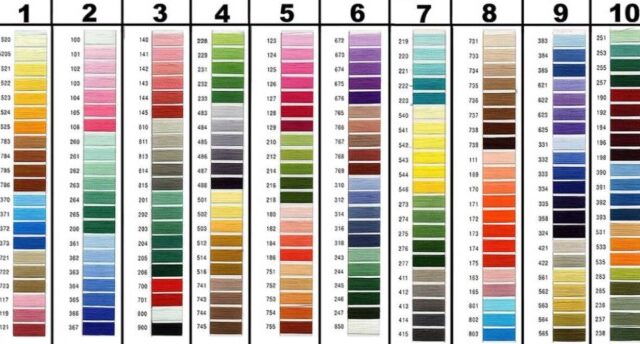When it comes to sewing, embroidery, or crafting, having the right set of thread colors can make a significant difference in the outcome of your projects. Selecting the best thread colors not only enhances the overall look but also provides versatility and readiness for various projects. In this guide, we’ll discuss the top thread colors to keep in your collection, essential tips for choosing and matching colors, and how to use these colors effectively to create stunning results.
Why Choosing the Right Thread Colors Matters
Thread color is often the defining factor in making a sewing or embroidery project look cohesive, professional, and polished. Colors can either blend into the fabric for subtlety or contrast boldly for a statement effect. Having a reliable set of thread colors saves time and ensures you’re always ready for any project, from repairing a seam to creating elaborate embroidery designs.
Essential Thread Colors for Every Collection
- Classic Black and White
- Black: Known for its versatility, black thread is essential for creating contrast or blending with darker fabrics.
- White: Equally versatile, white thread is perfect for lighter fabrics and often serves as the go-to option for basic stitching and hemming.
- Why They’re Essential: Black and white threads can work on a wide range of colors and are ideal for most types of stitching, from simple repairs to decorative elements.
- Neutral Gray
- Gray Tones: Gray thread works wonders for blending seamlessly into various fabric shades. Light, medium, and dark gray threads offer subtle differences that work across different tones of fabric.
- Usefulness in Projects: A neutral gray is particularly helpful for invisible stitching on multicolored or patterned fabrics.
- Basic Blue
- Navy Blue: A navy thread adds a subtle, sophisticated touch, commonly used in denim repairs and projects.
- Light Blue: Perfect for lighter-colored fabrics or for use in soft, airy projects like baby items or summer attire.
- Benefits: Blue is a universal color, and having a few shades can add variety and precision to your work.
- Red Hues
- Bright Red: For a bold pop of color, bright red is an excellent choice for decorative stitching and accentuating designs.
- Burgundy: More subdued than bright red, burgundy can create a rich, luxurious feel in your projects.
- Use in Crafts: Red tones are perfect for creating festive-themed projects, such as holiday decorations or Valentine’s Day items.
- Green Variants
- Forest Green: This dark, earthy tone is ideal for natural-inspired designs and projects that need a subtle, sophisticated touch.
- Emerald Green: A vibrant green shade is excellent for adding life to floral and outdoor-themed embroideries.
- Application in Crafts: Green hues can add realism to nature-inspired embroideries, making them appear lively and authentic.
- Yellow and Gold Tones
- Sunshine Yellow: This color is a fantastic choice for adding brightness and energy to your projects.
- Golden Yellow: Often used to create a regal or antique look, golden yellow works well in decorative borders and accents.
- Why It’s Needed: Yellow tones are incredibly versatile for uplifting the aesthetic and warmth of any design, especially in floral and spring-themed projects.
- Earthy Browns
- Dark Brown: Ideal for blending with darker fabrics, dark brown is also commonly used for realistic elements in embroidery.
- Beige or Tan: Perfect for neutral or rustic designs, beige offers a subtle and classy option.
- Usefulness: Brown tones work well for earthy designs, creating a grounded, natural look that complements various fabric colors.
- Purple and Violet
- Lavender: Soft and subtle, lavender is often used in delicate designs like floral embroideries or children’s apparel.
- Deep Purple: A rich purple shade adds elegance and sophistication, especially when paired with gold or other contrasting colors.
- Versatility in Designs: Purple shades are ideal for accentuating designs and creating a luxurious feel in projects.
Tips for Selecting Thread Colors
- Match the Fabric’s Undertones
- Identifying whether a fabric has cool, warm, or neutral undertones can guide your choice in thread colors. Cooler fabrics pair well with blues and grays, while warmer ones look great with earthy tones like browns and reds.
- Use Complementary Colors for Contrast
- For designs that pop, choose colors opposite on the color wheel. For example, blue and orange or red and green combinations can create visually striking designs.
- Consider the Purpose of the Thread
- Thread for hemming, for instance, should match the fabric closely, while decorative thread may contrast boldly for emphasis.
- Invest in Quality Thread
- Quality threads maintain color vibrancy and integrity over time. Investing in reliable brands will ensure your designs last and your threads remain consistent in hue and strength.
- Keep Shades for Different Seasons
- Consider having color variations that work well across seasons. Bright colors for summer, pastels for spring, and deeper hues like burgundy and forest green for fall and winter.
Practical Applications of Thread Colors
Home Decor Projects
Using versatile thread colors such as navy, gray, or beige can help create timeless home decor items. For instance, gray thread can be used for invisible hemming on curtains, while navy works well in throw pillows or upholstery projects for a classic touch.
Apparel Repairs and Alterations
Neutral colors like black, white, and gray are invaluable for repairs as they blend well with most fabrics. For more visible stitching on jeans or activewear, colors like navy or burgundy can add style while remaining understated.
Embroidery and Crafting
Decorative threads in vibrant shades like red, gold, and green can transform simple items into statement pieces. For example, using yellow and green in floral embroidery will create a lively, realistic effect.
Caring for Your Thread Collection
- Store in a Dry, Cool Place: Proper storage keeps thread from tangling and prevents fading.
- Organize by Color: Arranging thread by color family helps streamline your projects and prevents unnecessary searching.
- Use Thread Savers or Clips: To avoid loose ends and tangles, use small clips or thread savers around each spool.
Building a Sustainable and Versatile Thread Collection
Starting with essential colors like black, white, and gray, you can gradually expand to include vibrant shades and unique hues for specialty projects. Keeping these staples ensures your collection is both functional and inspiring, ready for any creative venture.
Final Thoughts on the Best Thread Colors to Have
Creating a well-rounded thread collection is about balance between functionality and creativity. From classic neutrals to vibrant shades, the best thread colors enable you to bring your sewing, embroidery, and crafting ideas to life. With the right colors, you’ll find yourself ready for any project that comes your way, whether it’s mending a loved piece of clothing or designing a bold embroidery. Building a thoughtful thread collection, coupled with your growing skills, will empower you to take on diverse projects and make each creation truly unique.
With these thread colors in your toolkit, you’re set to craft, stitch, and embellish with confidence, ensuring that each project showcases both durability and beautiful color harmony.



MOST COMMENTED
Business
World Politics News: Geopolitical Analysis for Strategic Decision-Makers
Business
World News Headlines: Global Developments Impacting Business and Policy
Business
Top World News Stories: What’s Shaping the Globe Today?
World News
Global News Updates: Stay Informed with Key Events
Crypto
“Current World News: Major Stories of 2025”
Crypto
Be1crypto.com Markets is a cryptocurrency trading platform designed to cater to both novice and experienced traders. It offers a user-friendly interface, a wide range of supported cryptocurrencies, advanced trading tools, and robust security measures. The platform aims to provide a seamless trading experience, allowing users to diversify their portfolios and engage in various trading activities.
World News
Chrisley Knows Best Daughter Dies: Unraveling the Truth Behind the Rumors